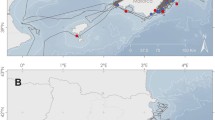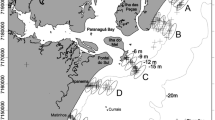Abstract
The Malindi–Ungwana Bay fishery Kenya is one of the most important marine fisheries of the Western Indian Ocean. There are two fishing grounds: Formosa and Malindi, with a designated 5-nM no-trawl zone offshore. However, the fishery was faced with numerous resource use conflicts and a decline in catches, culminating in a trawl ban in 2006. This study analyses catches and fishery dynamics before and after the 2006 trawl ban. Results show that artisanal landings declined before the ban, but rapidly recovered within 2 years after the ban was imposed. However, shrimp landings in the artisanal fishery remain low. Commercial shrimp landings gradually declined before the ban: ~550 t in 2001 to 250 t in 2006, and the shrimp: fish bycatch ratio was 1:1.5 compared to early reports of 1:7 in 1999. SIMPER analyses shows that 6 and 16 families (groups) accounted for 91.0 and 90.2% of the similarity in catch within the Formosa and Malindi fishing grounds, respectively. Formosa was important for Claridae, Cichlidae and Protopteridae, while Malindi recorded Carangidae, Siganidae, Carcharhinidae and Lethrinidae as the main families. Future studies should therefore embark on analyses of the factors driving the spatio-temporal distributions of the species and assess the impacts of bottom trawling on fishery dynamics before the trawl ban can be lifted.





Similar content being viewed by others
References
Fulanda B, Ohtomi J, Mueni E, Kimani E (2011) Fishery trends, resource-use and management system in the Ungwana Bay fishery, Kenya. Ocean Coast Manag 54:401–414
Government of Kenya (1991) Fisheries Act—laws of Kenya. Govt Press, Nairobi
Fulanda B (2003) Shrimp trawling in Ungwana Bay: a threat to fishery resources. In: Hoorweg J, Muthiga N (eds) Recent advances in coastal ecology: studies from Kenya. PrintPartners Ipskamp BV, Enschede, pp 233–242
Mwatha GK (2002) Assessment of the prawn fishery, bycatch, resource-use conflicts and performance of the turtle excluder device. In: Current status of trawl fishery of Malindi–Ungwana Bay. KMFRI Tech Rep 12/2002, pp 44–65
Fulanda B, Munga C, Ohtomi J, Osore M, Mugo R, Md. Hossain Y (2009) The structure and evolution of the coastal migrant fishery of Kenya. Ocean Coast Manag 52:459–466
Saetersdal G, Bianchi G, Stromme T, Venema C (1993) The Dr. Fridtjof Nansen Programme 1975–1993: investigations of fishery resources in developing countries—history of the programme and review of results. FAO, Rome
Iversen SA (1984) Kenyan marine fish resources in waters deeper than 10 meters investigated by R/V “Dr. Fridtjof Nansen”. In: Iversen SA, Myklevoll S (eds) Proc Joint Kenyan-Norwegian seminar, March 1984, Mombasa. NORAD, Bergen
Venema SC (1984) Review of marine resource surveys in Kenyan waters. In: Iversen SA, Myklevoll S (eds) Joint Kenyan-Norwegian seminar, March 1984, Mombasa. NORAD, Bergen
Nzioka RM (1979) Observations on the spawning seasons of East African reef fishes. J Fish Biol 14:329–342
Datoo BA (1974) Influence of monsoons on movement of dhows along the East African coast. East Afr Geogr Rev 12:23–33
Hoorweg J, Versleijen N, Wangila B, Degen A (2006) Income diversification and fishing practices among artisanal fishers on the Malindi-Kilifi coast. In: Hoorweg J, Muthiga N (eds) Advances in coastal ecology: people processes and ecosystems in Kenya. PrintPartners Ipskamp Bv, Enschede, pp 41–59
Jones JB (1992) Environmental impact of trawling on the seabed: a review. N Z J Mar Freshw Res 26:59–67
McClanahan TR (1988) Seasonality in East Africa’s coastal waters. Mar Ecol Prog Ser 44:191–199
Kaiser MJ, Spencer BE (1996) The effects of beam trawl disturbance on in faunal communities in different habitats. J Anim Ecol 65:48–358
Kaiser MJ, Hill AS, Ramsay K, Spencer BE, Brand AR, Veal LO, Prudden K, Rees EIS, Munday BW, Ball B, Hawkins SJ (1997) An estimate of fishing gear disturbance intensities in the Irish Sea: a comparison of beam trawling and scallop dredging. Aquat Conserv 6:269–285
Jennings S, Kaiser MJ (1998) The effects of fishing on marine ecosystems. Adv Mar Biol 34:201–351
Hall MA, Alverson DL, Metuzal KI (2000) By-catch; problems and solutions; seas at millennium: an environmental evaluation. In: Sheppard CR (ed) Global issues and processes, vol 3, pp 135–151
Eyo EA, Solarin BB, Isebor CE, Williams AB (2005) Assessment of fish by-catch species from coastal artisanal shrimp beam trawl fisheries in Nigeria. Fish Res 71:125–132
Chong KC, Dwponngo A, Ilyas S, Martosubroto P (1987) Some experiences and highlights of the Indonesian trawl ban: bioeconomics and socio-economics. Indo-Pac Fish Comm RAPA Rep 10, pp 458–477
Abuodha JOZ (2003) Grain size distribution and composition of modern dune and beach sediments, Malindi Bay coast Kenya. J Afr Earth Sci 36:41–54
Kitheka JU, Obiero M, Nthenge P (2005) River discharge, sediment transport and exchange in the Tana estuary Kenya. Estuar Coast Shelf Sci 63:455–468
McClanahan TR, Maina J, Pet-Soede L (2002) Effects of the 1998 coral mortality event on Kenyan coral reefs and fisheries. Ambio 31:7–8
Clarke KR (1993) Non-parametric multivariate analyses of changes in community structure. Aust J Ecol 18:117–143
Bray JR, Curtis JT (1957) An ordination of the upland forest communities of southern Wisconsin. Ecol Monogr 27:325–349
Govt of Kenya (2008) Marine waters fisheries frame survey report, Fish Dept, Nairobi
Arntz WE, Tarazona J (1990) Effects of El Niño 1982–83 on benthos, fish and fisheries off the South American Pacific Coast. Elsevier Oceanogr Ser 52:323–360
Schwing FB, Palacios DM, Bograd SJ (2003) El Niño impacts of the California current ecosystem. NOAA Fisheries, SWFSC, CA
Schwing FB, Murphree T, deWitt L, Green PM (2002) The evolution of oceanic and atmospheric anomalies in the Northeast Pacific during the El Niño and La Nina events of 1995–2000. Prog Oceanogr 54:459–4911
Garcia AM, Vieira JP, Winemiller KO (2003) Effects of 1997–1998 El Niño on the dynamics of the shallow-water fish assemblage of the Patos Lagoon Estuary (Brazil). Est Coast Shelf Sci 57(3):489–500
Govt of Kenya (2001) Gazette notice No 7565 of 31/10/2001
Mueni E, Mwangi J (2001) A survey on the use of turtle excluder devices (TEDs) in trawlers along the Kenyan coast. KWS Tech Rep, Mombasa
Fennessy ST, Mwatha GK, Thiele W (2004) Report of the regional workshop on approaches to reducing shrimp trawl by-catch in the Western Indian Ocean. Mombasa, Kenya. FAO, Rome
Macia A (2004) Juvenile Penaeid Shrimp Density, Spatial Distribution and Size Composition in four adjacent habitats within a Mangrove-Fringed Bay on Inhaca Island, Mozambique. J West Indian Ocean Mar Sci 3:163–178
Bishop JM, Khan MH (1991) Depth as a factor in abundance and size of juvenile penaeid shrimps in the absence of estuaries and marshes. Mar Biol 109:103–114
Somers IF (1987) Sediment type as factor in the distribution of prawn species in the western Gulf of Carpentaria. Aust J Mar Freshw Res 38:133–149
Somers IF (1994) Species composition and distribution of commercial penaeid prawn catches in the Gulf of Carpentaria Australia, in relation to depth and sediment type. Austr J Mar Freshw Res 45:317–335
Gribblea NA, Wassenberg TJ, Burridge C (2007) Factors affecting the distribution of commercially exploited penaeid prawns (shrimp) (Decapod: Penaeidae) across the northern Great Barrier Reef, Australia. Fish Res 85:174–185
Mwaluma J (2002) Zooplankton abundance, distribution and species composition in Ungwana Bay. KMFRI Tech Rep-12/2001, pp 20–23
Fiorentino F, Badalamenti F, D’Anna G, Garofalo G, Gianguzza P, Gristina M, Pipitone C, Rizzo C, Fortibuoni T (2008) Changes in spawning-stock structure and recruitment pattern of red mullet Mullus barbatus after a trawl ban in the Gulf of Castellammare (central Mediterranean Sea). ICES J Mar Sci 65(7):1175–1183
Acknowledgments
This publication was made possible by Flemish VLIR ICP scholarship funding from the Marine Biology Division of Ghent University, Belgium. The authors express their gratitude to the director of Kenya Marine & Fisheries Research Institute for the logistical support, and the Fisheries Department-Kenya for providing the archived data and statistics on the Malindi–Ungwana Bay fishery. To all fellow researchers at KMFRI and the fishers who took part in these surveys in one way or the other, we cannot adequately thank you, but we do hope these studies will go a long way in solving the resource use conflicts and problems of management in the marine and coastal fisheries of Kenya.
Author information
Authors and Affiliations
Corresponding author
Rights and permissions
About this article
Cite this article
Munga, C., Ndegwa, S., Fulanda, B. et al. Bottom shrimp trawling impacts on species distribution and fishery dynamics; Ungwana Bay fishery Kenya before and after the 2006 trawl ban. Fish Sci 78, 209–219 (2012). https://doi.org/10.1007/s12562-011-0458-0
Received:
Accepted:
Published:
Issue Date:
DOI: https://doi.org/10.1007/s12562-011-0458-0




